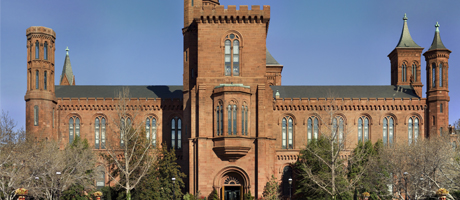Which poultry farms are sending harmful bacteria into the Chesapeake Bay? How are cell phones changing linguistics? George Washington University and Smithsonian researchers hope to answer these questions and others as part of new joint research projects that the institutions announced today. The five new initiatives will focus on Exploration of Maritime Archaeology of the Transatlantic Slave Trade; Primate Breast Milk: Effect on Infant Growth, Development, and Adult Disease; Analysis of Political and Cultural Ecologies of Cell Phones; Impact of Turbulence on Distribution of Dissolved Gases in Aquatic Environments; and Effect of Watershed Discharge of Poultry Feeding Operations.
GW President Steven Knapp and Smithsonian Secretary Wayne Clough each pledged $100,000 to support new collaborative research projects by signing a Memorandum of Understanding last year. As a result of that agreement, the GW–Smithsonian Opportunity Fund was created and five projects have now been selected to receive approximately $40,000 each in joint funding. The new initiatives will be led by a team of investigators from both institutions.
“GW and the Smithsonian Institution have a long history of collaboration,” said Randall Packer, associate dean and professor of biology at GW’s Columbian College of Arts and Sciences. “The Opportunity Fund allows us to expand the scope of those collaborations, bringing together researchers who have shared interests but who have not had the opportunity to work together. It is our hope that the collaborations will be productive and long lasting.”
The new projects receiving support through the GW–Smithsonian Opportunity Fund are as follows:
Exploration of Maritime Archaeology of the Transatlantic Slave Trade
Associate Professor of Anthropology Stephen Lubkemann and Paul Gardullo, museum curator at the Smithsonian’s National Museum of African American History and Culture, will lead an international research team to locate, document, and secure unique—and increasingly threatened—archaeological remains related to the maritime aspects of the slave trade. The primary goal of the collaborative effort is to track and document the history of two ship-wrecked vessels that played pivotal roles in the trans-Atlantic slave trade: the Sao Jose, which wrecked near Cape Town, South Africa in 1794 while carrying more than 500 slaves from Mozambique to Brazil; and the L’Aurore, which foundered near Mozambique Island with 600 slaves destined for the Americas.
Primate Breast Milk: Effect on Infant Growth, Development, and Adult Disease
Assistant Professor of Anthropology Robin Bernstein and Michael Power, animal scientist at the Smithsonian Conservation Biology Institute’s Nutrition Laboratory and Conservation Ecology Center at the National Zoological Park, will partner on a comparative study of regulatory molecules in breast milk of nonhuman primates. Currently, there is no study like this in existence due to the difficulty associated with obtaining samples of breast milk. Power, as acting curator of the National Zoo’s milk repository, will enable access to the repository’s collection of 15,000 milk samples from nearly 140 species of mammals, including 30 primate species. Bernstein is an expert in the physiology of growth and development in nonhuman primates and has recently initiated an international collaboration to measure proteins in human breast milk. Their joint effort will produce new information about maternal-infant physiology from evolutionary and human disease perspectives.
Analysis of Political and Cultural Ecologies of Cell Phones
Professor of Anthropology and International Affairs Joel Kuipers and Joshua Bell, curator in anthropology at the Smithsonian’s National Museum of Natural History, are collaborating to create a new exhibit on the Political Ecologies of Cell Phones. This interdisciplinary project will examine the development of new cultural patterns associated with the cell phone, focusing on the phone as a communications instrument and on the ecological networks in which it rose as a commodity. Graduate students will assist in researching the diversity of cell phone cultures in four D.C. area communities with regard to linguistic, social, graphic, and material features. The impact of cell phones on cultural relations between the communications instrument used, intimacy, and choice in social relations will also be explored. In spring 2012, a series of workshops will be conducted on the commodity chains and ecologies that cell phones inhabit; how mobile technologies have changed our patterns of communication; and the design and aesthetics of cell phones. These workshops will help inform the content and design of the planned exhibit.
Impact of Turbulence on Distribution of Dissolved Gases in Aquatic Environments
Assistant Professor of Engineering and Applied Science Philippe Bardet will work with senior scientists Denise Breitburg and Thomas Jordan, and postdoctoral fellow Keryn Gedan at the Smithsonian Environmental Research Center to investigate factors controlling the concentrations and dispersal of dissolved oxygen in aquatic environments. The study will involve combining data on fluid mechanics and laser diagnostics, knowledge of ecosystem processes in flowing water, and expertise on the dynamics and effects of oxygen in habitats along the bottom of a lake or deep river. With this data, the team will develop laboratory and field experiments that will simultaneously measure the water velocity and dissolved oxygen concentrations. The results will be relevant to environmental management and restoration.
Effect of Watershed Discharge of Poultry Feeding Operations
Assistant Professor of Environmental and Occupational Health Jay Graham and Thomas Jordan, senior scientist at the Smithsonian Environmental Research Center, are combining efforts to investigate the environmental and public health impacts of poultry operations on watershed discharges. Their goal is to develop a new approach for tracking contaminants and their sources. Using the Chesapeake Bay basin as their laboratory, the researchers will compare nutrients and antimicrobial-resistant pathogenic bacteria—known to cause 36,000 human deaths worldwide per year—in several streams draining from area watersheds. By contrasting the levels of poultry litter, which contains the bacteria, they will be able to determine which poultry operations negatively impact the streams in the watersheds and thereby the Chesapeake Bay basin.


